
20 minute read
Member News
from IPLOCA Newsletter 98
by Pedemex BV
Al-Qahtani Pipe Coating Industries awarded Aramco contract
Saudi energy company Aramco has awarded a contract to Al-Qahtani Pipe Coating Industries for work on the Master Gas System (MGS) expansion. The project involves 414 kilometres of 56”, 30” & 24” diameter pipes’ double joint welding and external FBE coating. The original MGS was built in the 1970s. Since then, Aramco has been supplying natural gas to its customers across Saudi Arabia via the network, mainly channeling associated gas from Ghawar and other oil fields. Over the past decade, amid rising gas demand from Saudi Arabia’s industrial and household sectors, Aramco has undertaken projects to increase its non-associated gas production. It launched the second expansion phase of the MGS in 2015. The pipeline construction was completed in 2021, increasing the gas handling and transport capacity of the MGS from 8.4 billion cubic feet a day to 12.5 billion. Saudi Aramco’s MGS expansion - Phase III project - aims to convert a number of power plants from oil to natural gas, contributing to the country’s drive towards a cleaner energy mix.
Main contractor AVAX S.A. completes 47% of major high-pressure pipeline in Greece
The West Macedonia pipeline, planned to be handed over by the first trimester of 2025, will be the first highpressure transmission gas pipeline in Greece, certified to transport up to 100% hydrogen and one of the first in Europe. It is part of the European Hydrogen Backbone, the infrastructure needed to achieve Europe’s climate and energy objectives. Pipes comply with ASME B31.12 Option B specification. Once the construction carried out on behalf of DESFA is completed, the pipeline will provide a technically and economically feasible solution for the safe transportation of hydrogen at high pressures through large diameter and high strength steel pipelines. Thus, pipes produced today and installed in the current gas network can cover the energy mix of tomorrow. The natural gas pipeline covers Greece’s northern region of West Macedonia with a total length of 163 km of coated steel pipes (97km of LSAW 30’’ and 66km of ERW 14” and 10”).

Bezemer completes shore crossings for Deutsche Ostsee LNG terminal
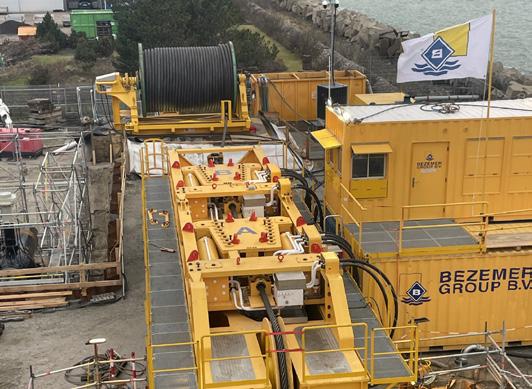
Winch supplier Bezemer Dordrecht provided equipment for the “Deutsche Ostsee Project”, a new Floating Storage Regasification Unit (FSRU) - based LNG import terminal near Lubmin, Germany. The project included a pipeline shore crossing through a micro-tunnel. Bezemer Dordrecht supplied a continuous linear winch with a pulling capacity of 800 tonnes to complete this part of the project. Since the pull is through a micro-tunnel, the linear winch was delivered with a tunnel pit frame. This frame, originally designed for these kinds of projects, has an incorporated downward sheave to position the winch on top of the pit. Using different inserts, the winch pulls wires of various diameters allowing one winch to pull a 52mm messenger wire and a 127 mm pull wire, to which the pipeline is connected. Following the completion of the pull in September, the German government decided to have the offshore moored FSRU moved to Sassnitz. Bezemer repeated the operation at Mukran Port, where the pipeline shore crossing was completed in December 2023.
Bin Quraya awarded contract to increase crude supply to Ras Tanura

Bin Quraya Company Limited signed a contract in December 2023 to increase the capacity of Ras Tanura Terminal. The Eastern Region terminals of Saudi Arabia consisting of Juaymah Crude Oil Terminal (JCOT) and Ras Tanura Terminal (RTT) experience unbalanced utilisation when exporting at maximum sustainable capability (MSC). JCOT has high utilisation of approximately 85%, whereas RTT is operating at approximately 60% of capacity. The scope of work is to install a new 32” diameter, 25 km long pipeline (KRT-2L) within the existing corridor from SJ-1 at KM @199 to RT Terminal North (TN) to support a total of 850 million barrels per day (mbd) Arabian Medium (AM) supply to RTT. The scraper receiver lateral line of the new KRT-2L will be connected to several feeding lines. Some piping modifications and other tie-ins will be required across the pipeline network and in RTT (TN and TS). The facilities will include the installation of tie-ins at RTT North and South, piping modifications, two jump overs, a scraper launcher and receiver, a valve station, cathodic protection, electrical and instrumentation. The work comprises services to Qatif Gas and Oil Separation Plant with existing scraper trap facilities and a closed drain system, Qatif Central processing facilities, a medium level voltage station and motor operated valves for operational flexibility.
Electrification and energy solutions at Caterpillar
To amplify electrification and energy solutions, Caterpillar featured breakthrough innovations and next generation products and services at the forefront of electrification at the Consumer Electronics Show (CES) 2024 that took place in Las Vegas, U.S.A. in January 2024. The exhibit highlighted Caterpillar’s electric machines and energy solutions, designed to meet the evolving needs of construction industry customers as they electrify their job sites. As a technology leader for nearly a century, Caterpillar continues to innovate and invest in electrification, alternative fuels, connectivity, and digital solutions to help customers meet their sustainability goals. Exhibit visitors were drawn to the two electric machines on display: a zero-exhaust-emission underground loader for mining that included the industry’s only onboard battery with fast-charging capabilities and a hydraulic excavator. Furthermore, the exhibit demonstrated Caterpillar’s broad portfolio of integrated solutions designed to help customers electrify their job sites. The technology showcased included on-site power generation: generators capable of running on renewable fuels, solar panels, and hydrogen-powered fuel cells. Also on display were energy storage solutions that work with any combination of diesel, natural gas, or renewable energy sources for optimal power. Chargers, rigged battery packs with built-in telematics and inverters were also featured. Find out more about Caterpillar at CES 2024 at: www.cat. com/en_US/campaigns/event/cat-at-ces.html

C.A.T. Group expands commitment to sustainability and commences construction on ADNOC Estidama Project
In a move to address the climate challenge and amplify its commitment to community welfare, C.A.T. Group has recently established a dedicated sustainability department and formed a committee to spearhead environmental efforts, including a thorough assessment of CO2 emissions and the implementation of ambitious reduction targets. Highlighting its dedication to renewable energy, C.A.T. has installed a solar carport at its Dhahran head office, powering office lighting. Solar-powered cooling sheds have been introduced at various sites for employee comfort during harsh weather conditions. The company’s fleet has undergone a green transformation with hybrid cars, electric forklifts, and Euro 3 compliant trucks, showcasing its commitment to emission reduction. Complementing these eco-friendly measures, C.A.T. actively contributes to local green initiatives, such as the beautification of the Dammam gate roundabout, and supports diversity in the workforce by encouraging Saudi women to take up diverse roles, including welding and QA/QC inspection. The first Saudi woman to receive the ACI Certification in KSA is a member of the C.A.T. team. The C.A.T. Group and NPCC consortium has initiated full-scale construction on the Estidama - Sales Gas Pipeline Network EnhancementPackage 3 project in Abu Dhabi, U.A.E. Valued at over USD 600 million, the initiative aims to ensure a sustainable and cost-effective natural gas supply, supporting ADNOC’s growth strategy. The project involves the installation of 191 kilometres of 56” and 52” sales gas pipelines.

China Petroleum Pipeline Engineering Co., Ltd. (CPP) employs cutting-edge engineering capabilities in Abu Dhabi
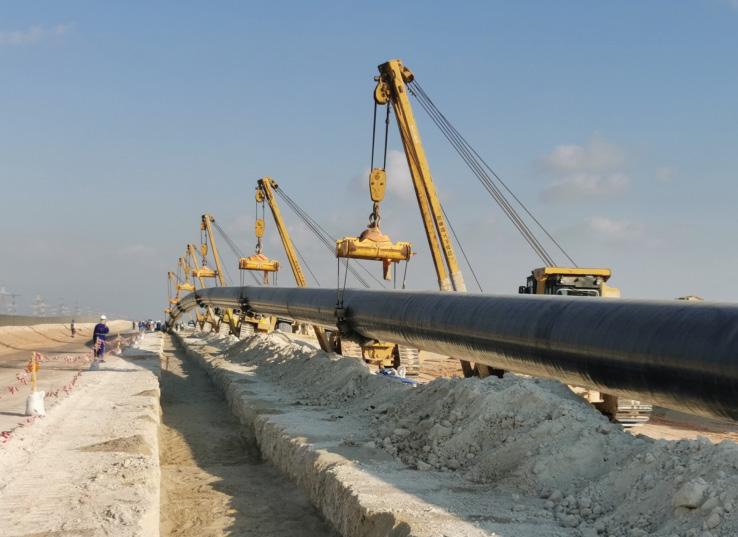
to address a growing nitrogen demand. The main scope of work covers the installation of a nitrogen pipeline covering 75 kilometres from the Mirfa plant to Ruwais. The contract was awarded to CPP by ADNOC Gas Processing. Designed as a fast-track project, the construction timeline given was 24 months. Key components include a 75-kilometre 48-inch pipeline and a 5-kilometre 12-inch pipeline. The scope extends to the construction and modification of metering stations, receiving stations and valve stations. Pipelines are laid in areas with high water levels, requiring specialised construction. The project also features 16 non-disruptive road crossing (NDRC) points and two hot tapping locations. CPP, the EPC contractor, has employed fully automatic welding technology, achieving an outstanding milestone in the U.A.E. – surpassing 80 joints per day for the 48” main pipeline. The maximum daily single crew welding capacity was 900 metres. The Vacuum Pipe Lifter was introduced for the first time in the U.A.E., increasing efficiency by over 50% during pipe unloading and laying. The project, advancing faster than scheduled, is expected to be completed by mid-November 2024.
De Romein Group installs pipelines connecting offshore windfarms to the grid
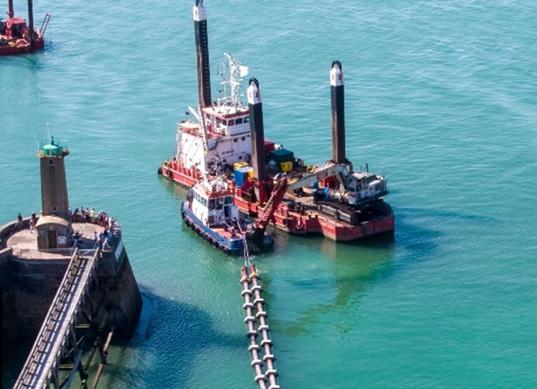
De Romein Group is increasingly active in nearshore cable enabling works across Europe. These works often include the installation of HDPE pipelines, which function as ducts to pull HVDC cables through, connecting offshore windfarms to the grid. In 2023, De Romein Group successfully delivered a 680 m long and 630mm diameter HDPE duct pipeline installation with concrete ballasts and a 2 km marine dredge for the Fécamp offshore windfarm project in France. Using De Romein’s specialist nearshore fleet, which includes the Capall Mara, a 500-tonne backhoe dredger, from which a Liebherr R 984 excavator is operated, a 2-metre-deep trench was dug along the seabed and the pipeline anchored in the trench. Capall Mara was supported by other vessels including a 120-tonne deck load capacity jack-up barge, offshore rigid inflatable boats (for crew transport) and shallow water work boats. In many of De Romein’s other cable enabling projects horizontal directional drilling is undertaken from the shoreline, to insert the HDPE pipeline ducts to a defined point in the trench. Following the pipeline installation on the Fécamp project, De Romein also successfully carried out the HVDC cable pull installation and marine civil works.
Goriziane’s Pipe Bending Machine updated with latest technology

Pipeline projects demand precision, efficiency, and reliability in every aspect of construction. In this quest for excellence, the role of cutting-edge technology becomes increasingly vital. One such technological marvel that has revolutionized the pipeline industry is Goriziane’s Pipe Bending Machine, specifically designed for large-scale projects with pipes measuring 36 inches and above. In the dynamic landscape of pipeline construction, the use of advanced technologies, like the 36” and above pipe bending machines, is a strategic choice. The efficiency, precision, and safety offered by these machines not only expedite project timelines but also elevate the overall quality of the pipelines being constructed. As pipeline projects continue to grow in complexity and scale, the role of these cutting-edge machines becomes increasingly pivotal in shaping a sustainable and resilient future for the industry.
Herrenknecht’s small diameter Direct Pipe deployed for European gas pipeline network
In highly permeable ground conditions, when horizontal directional drilling (HDD) is not applicable or feasible, Herrenknecht’s Direct Pipe technology (sometimes also called “Direct Steerable Pipe Thrusting” or DSPT) provides a safe option for crossings and landfalls. The AVNS slurry MTBM concept with an integrated jet pump system extends possible drive lengths to 1,500 metres for small-diameter Direct Pipe installations from 24” upwards. Further developments in the navigation system eliminate the use of magnetic-field detection systems. This makes small Direct Pipe even simpler, more reliable and versatile, opening new opportunities for owners and consultants when planning pipeline networks or underground cable routes. The safety benefit of slurry-based micro tunnelling and its high precision and performance rates in a wide range of ground conditions ensures a high-level of acceptance and reliability. After the first two 28” river crossings commissioned in Poland for the GIPL-Gas Interconnector Poland-Lithuania, a total of five crossings were commissioned by Gaz-System, with a maximum installation length of 884 m. Early 2023, small-diameter Direct Pipe installations were successfully completed in Italy for SNAM Rete Gas. Two sections of the Pipeline at Recanati–Chieti were installed, using an AVNS600 Direct Pipe MTBM and a 500-ton Pipe Thruster.
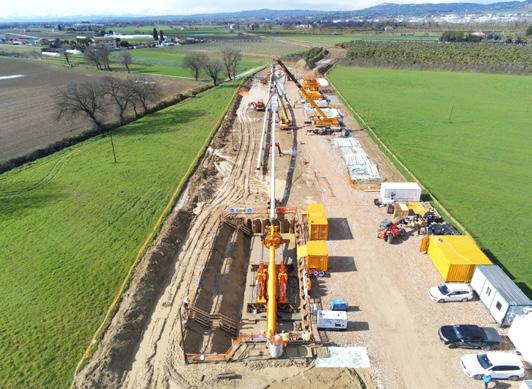
ILF white paper on bulk transport options for green molecules
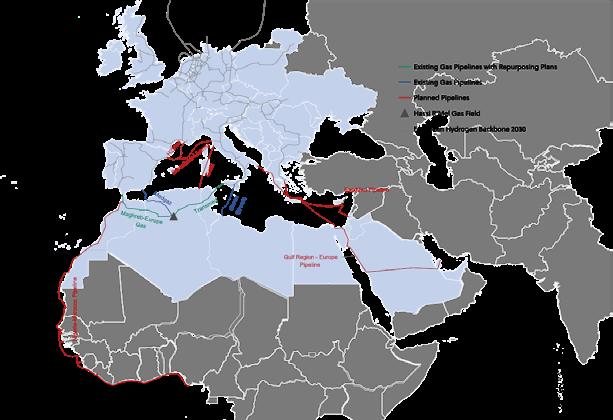
The global hydrogen trade is projected to undergo a significant transformation by 2030, primarily focusing on the European Union, Japan and South Korea due to their strict emissions regulations and limited local production. The MENA region, as well as countries like Mauritania, Namibia, South Africa, Brazil, Chile, Argentina and Canada are expected to emerge as major hydrogen suppliers. Repurposing existing gas pipelines is a vital strategy for developing the hydrogen market, although logistical challenges remain. In their joint white paper, “Bulk transport options for green molecules”, ILF Consulting Engineers’ Management Consulting Team and Dii Desert Energy compared the levelized cost of hydrogen transportation for different existing and planned pipelines. The report analyses the global hydrogen trade and examines the role of cross continent pipelines. It offers selected expert interviews with key players in the green molecules value chain. The white paper is available for download here: www.ilf.com/news/publications/?downloadid=1584864 .
Attracting new talent tops list for issues facing midstream industry
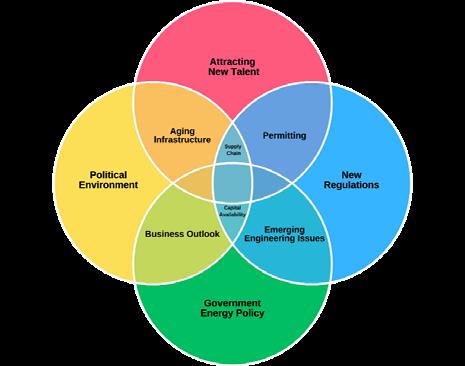
Lamar University’s Center for Midstream Management and Science conducted its 2024 “Top ten issues facing the midstream industry” survey, which yielded the following results. The top 10 issues include attracting new talent, the political environment, new regulations, government energy policy, aging infrastructure, business outlook, emerging engineering issues, permitting, capital availability and supply chain. Last year, human capital and what can be called day-to-day operating worries dominated industry concerns. In this year’s survey, attracting new talent took first place again, but in an unexpected result, day-to-day operating concerns were replaced by political environment. Attracting new talent and political environment were not only very close in scoring but were also significantly more important than the remaining eight issues. The next two issues, new regulations and government energy policies, were tied in scoring. Authors of the survey suggest it may be time for the midstream industry to reassess its interaction with the public, perhaps through an educational initiative targeting university students, energy consumers, and all levels of federal, state, and local government. The survey is available at: www.lamar. edu/midstreamcenter/newsfeed/top-ten-issues-facingmidstream-industry-in-2024.html
LaValley Industries forge alliance with CRC Evans
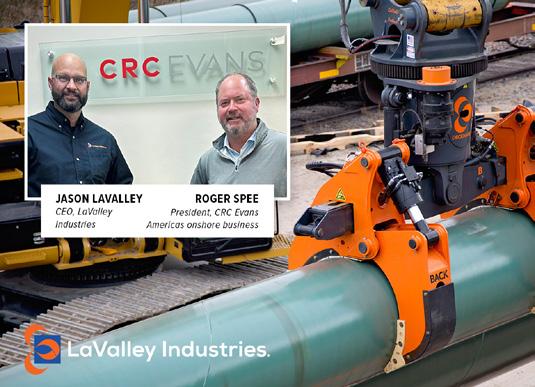
LaValley Industries announces the reacquisition of its DECKHAND® rental fleet from long-time industry associate CRC Evans. This development positions the manufacturer as the largest global DECKHAND® rental provider. LaValley Industries products have been transforming infrastructure job sites worldwide for over a decade. Designed with the operator in mind, manoeuvring pipe, poles, drill rod, I-beams and road mats has never been easier or safer. With this acquisition, the company is bringing together manufacturing excellence and rental service under one roof. CRC Evans will play a key role in this new chapter for LaValley Industries while continuing to deliver state-ofthe-art services and equipment solutions. This partnership is a natural evolution of both companies’ shared values and commitment to excellence. LaValley Industries’ customers can expect an even more responsive service and support as the company reinforces its commitment to unparalleled precision, safety and efficiency in job site operations. Customers can rent attachments directly from the manufacturer or explore equipment rental packages offered by the LaValley Alliance Partner Network.
Lincoln Electric offers innovative approach to pipeline welding
With the release of the new Mechanized Pipeliner® AutoShield® solution, Lincoln Electric has helped usher in the next generation of pipeline welding. Ideal for contractors looking for a more cost-effective way to mechanize their welding operations, the advancements provided by AutoShield help deliver more reliable, repeatable welds for X65 and X70 downhill welding applications. Designed for fill and cap welding passes, it is a complete mechanized, self-shielded flux-cored (FCAW-S) solution that offers an innovative approach to eliminating shielding gas and welding shacks out on the right-of-way - helping to reduce weld time by up to 30% when compared to similar SMAW applications. It also offers up to 50% reduced heat input when compared to similar FCAW-G applications.
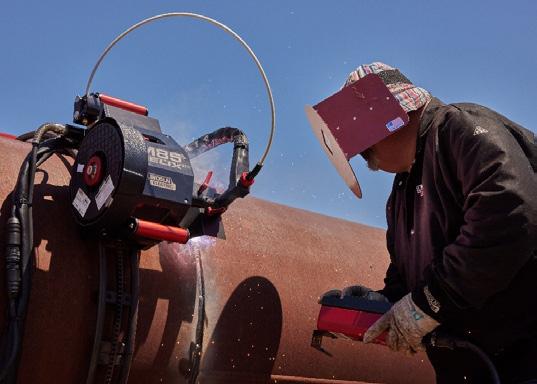
MAX STREICHER S.p.A. participates in construction of renewable diesel plant in Rotterdam

The Finnish company Neste recently launched a new project to enhance the production capacity at its Rotterdam refinery in the Netherlands by introducing a plant capable of producing 1.3 Mt of renewable diesel annually. The project is divided into four construction lots, of which MAX STREICHER S.p.A. has been awarded the contract for mechanical works, the largest one of the four in terms of quantities and effort. The project started this year and is scheduled to be completed by June 2025 with an expected start of operation by 2026. MAX STREICHER S.p.A. is in charge of several construction activities, including piping prefabrication, piping erection and painting works, as well as mechanical hoisting and assembly works, pre-commissioning works and assistance to commissioning activities. Welding processes with noble materials will be executed. The installation of heavy equipment of substantial weight and size will require the use of cranes, up to a capacity of 1,200 tons, as well as the installation of rotating machines requiring the expertise of professional teams. The project is expected to employ more than 300 workers at its peak.
Monter Strojarske Montaže d.d. completes underground gas storage facility

The project, listed among the strategic investment initiatives in Croatia, involved the construction of a gas station with a compressor station, serving as the central facility for gas production, and a gas dehydration unit in Grubišno Polje. As part of the project, gas pipelines were built to connect two production wells, and a measuring station was created with connecting pipelines to the entry point of the transportation system. The facility was commissioned, entering a trial operation phase in July 2023. The completion of this underground gas storage project not only marks a significant achievement for Monter Strojarske Montaže d.d., but also contributes to Croatia’s strategic energy infrastructure. The successful integration of the gas production and storage facility enhances the country’s energy security and represents a vital step in fostering sustainable and efficient energy management.
PEAL’s innovative risk management approach
PEAL Engineering and Construction was recently contracted for mechanical construction on a booster compressor project in Bibiyana Gas Field, Hobiganj,
Bangladesh. The project, awarded by a global oil and gas company, aimed to enhance long-term operation and production. PEAL encountered a major risk, namely extreme summer heat in the month of May and June 2023 during the full phase of execution with temperatures hitting 40°C and humidity at 96%. The typical 15-minute heat breaks mandated by compliance weren’t enough so a risk response plan was developed. 30 minutes of additional time was required to resume work. PEAL’s innovative approach included a hydration and energy boost: water, bananas, glucose and electrolytes were provided for instant energy replenishment. Medical support and monitoring: on-site medical support was set up to ensure worker safety and prioritise treatment. Enhanced cooling measures: temporary sheds, water sprays and stand fans were used to mitigate extreme temperatures. Age-focused strategies: workers over 40 were given less strenuous tasks with health checks for proactive assistance. Work optimisation: whenever possible, tasks were prioritised based on heat tolerance and hot work was moved to controlled fabrication shop environments. These strategies yielded impressive results. Worker morale remained high, productivity losses were minimised, and the project was delivered on schedule to the client’s satisfaction.

SICIM S.p.A. awarded major gas utilisation project in Iraq
Over the 12 years of its presence in Iraq, SICIM successfully implemented several oil and gas projects, not only supporting the expansion of the national energy infrastructure, but also providing jobs and professional development opportunities to local communities creating a mutually beneficial and sustainable business environment. SICIM has expanded its portfolio of EPC projects in Iraq with a new plant, which includes the design, procurement, construction and commissioning of a gas sweetening unit, critical for sustainable power generation at the West Qurna-2 field, and raw gas compression and dehydration facilities that will condition raw gas for its subsequent export to the downstream centralized gas hub for final processing. The ambitious project, planned to be completed within 33 months, provides employment to hundreds of qualified and semiskilled Iraqi citizens. Dozens of local Iraqi subcontractors and service providers will have the opportunity to work on the project. By minimizing gas flaring, the plant will play an important role in the decarbonization of the Basra region, as well as help reduce Iraq’s dependence on imported gas.

New documentary premieres about construction of Néstor Kirchner Pipeline
Celebrating engineering prowess and collective effort, the documentary ‘GPNK: El Camino del Gas’ premiered at the 38 th Mar del Plata International Film Festival in Argentina. The film, available on YouTube, provides insight into the construction of the Presidente Néstor Kirchner Gas Pipeline (GPNK), and chronicles Techint Group’s efforts to build a key piece of energy infrastructure. The 35-minute film, directed by Gianfranco Quattrini, documents how the pipeline was completed in just ten months, when building infrastructure of this scale normally takes two years. The documentary captures the experiences of over 4,000 people involved in the construction. Special screenings were organised for local communities involved in this mega project. The 36-inch diameter pipeline with a total length of 573 km transports natural gas produced in Vaca Muerta to the province of Buenos Aires. It will increase the country’s natural gas transportation capacity by 30%. “It’s impressive how we have managed to come together with a collective vision, as a group that combines all its strength for gas, to achieve something very important for the country,” said Paolo Rocca, President of the Techint Group. The film is available here: www.youtube.com/ watch?v=LqFHqKiLlAc

Vacuworx lifters used on Australian pipeline project
A large coal mining project in central Queensland, Australia, required two Vacuworx lifters for the installation of a new 500 mm HDPE pipeline. The purpose of the pipeline is to transport water to a coal washing facility and aid in dust suppression – a critical task due to erosion concerns and the proximity of neighbouring agricultural activities. For the successful execution of this project, two Vacuworx lifters were employed – one RC
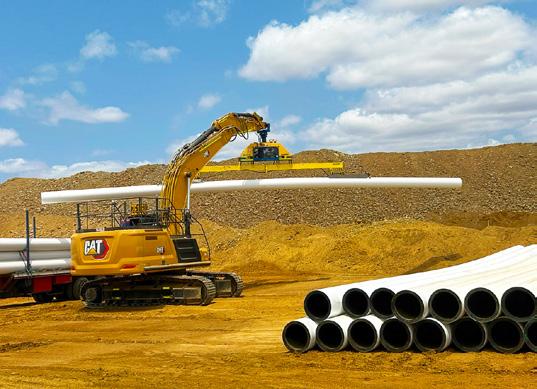
10 and one RC 12. Both lifters underwent ‘Mine-Spec’ preparation, incorporating features such as battery isolation and E-Stop switches, protective covers on all electrical terminals, and high-visibility equipment number stickers. Each lifter was equipped with an 8-metre spreader beam and dual pads, specifically designed to handle 21-metre lengths of HDPE pipe. This functionality supported the unloading of incoming pipes and their transportation from the stockpile to the welding process. The welding process involved creating 150-metre strings from each welder, subsequently pulling them into the right-of-way before joining each string and trenching them into the ground.










